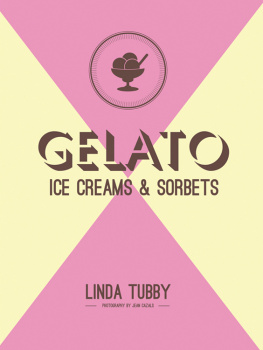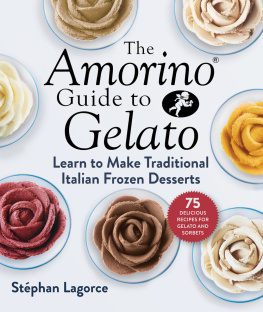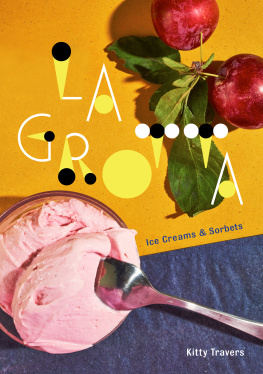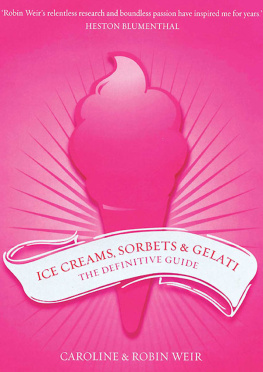GELATO
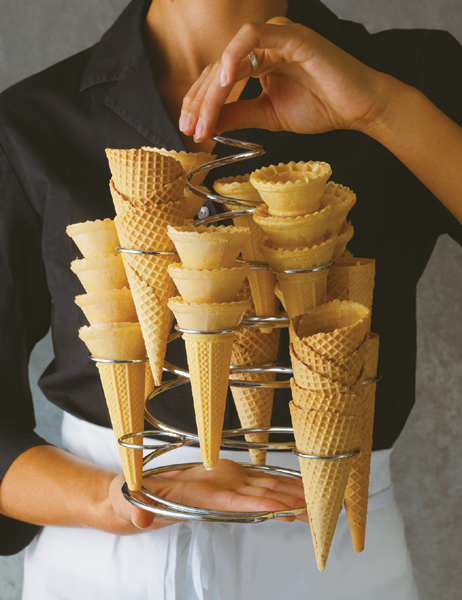
GELATO
ICE CREAMS & SORBETS
LINDA TUBBY
Photography by Jean Cazals

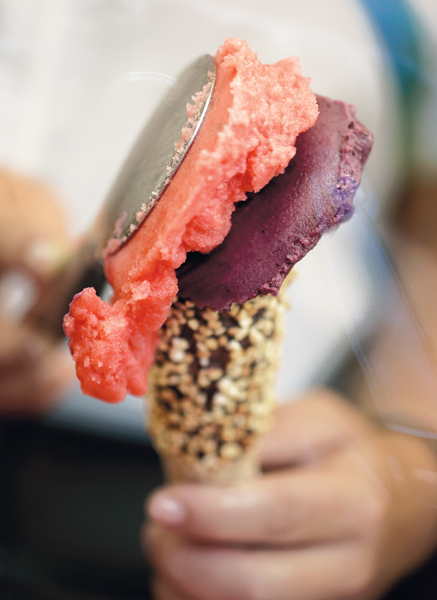
Dedicated to my sons Dan and Ben and my friend Ruth Prentice, with love
CONTENTS
THE SNOW AND ICE AGE
There is a lack of credibility in many of the stories surrounding the origins of Italian ices. Most are based on myths and legends but a number are plausibly linked to real historic events and provide a fascinating trail through a variety of countries. Like many inventions, it is often difficult to pinpoint one source or inventor, or even specific dates for that matter. Looking into the concept of the discovery of gelato, I found myself following the most tenuous of links and unearthed some fascinating stories.
One tale talks of the Venetian traveller and writer, Marco Polo, bringing the concept of frozen ices back to Italy from China. It is said, but hotly disputed, that he observed the Chinese using ice and fermented milk in a way that would later be developed in Italy during the 16th century. The Chinese knew about the usefulness of harvesting and storing snow and ice and had been freezing things for thousands of years. The widespread use of this natural cooler, teamed with exotically flavoured syrups, was also being enjoyed before the time of Marco Polo in India and Persia. Arab traders travelled with this knowledge, and settled the habit firmly with the Sicilians, who later perfected the art. The indication is that the first sorbetto was simply a loosely frozen, highly aromatic and sweet drink.
Long before Marco Polo, the Romans knew all about how to make full use of the seasonal harvest of snow and ice. Iced drinks bevande ghiacciate were part of everyday life in Rome. Slave runners carried huge blocks of icy snow down from the mountains not far from the city. Storing snow for use throughout the hot summers was a necessity. It was used to add a chill to the warm, heavy wine, making it more palatable. Snow also supplied a treat of pure icy slush, which could then be flavoured with fruit and honey syrups. Emperor Nero Claudius had an unquenchable liking for ice-cold wine. The drinking vessel used at the time was revolutionary it had two chambers, the outer packed with snow and the inner chamber containing the drink itself.
Towards the end of the 16th century a number of people in Naples were playing with the idea of freezing. One scientist in particular, Giambattista Della Porta, was forging ahead with his own experiments using cooling techniques that worked well enough to freeze diluted wine. The temperature of water drops when salt is added and dissolved into it initially saltpetre was used. It was later found that normal salt crystals did the job perfectly well. This process of freezing was made all the more powerful by rotating a vessel filled with liquid buried in a snow and salt mixture called salamoia .
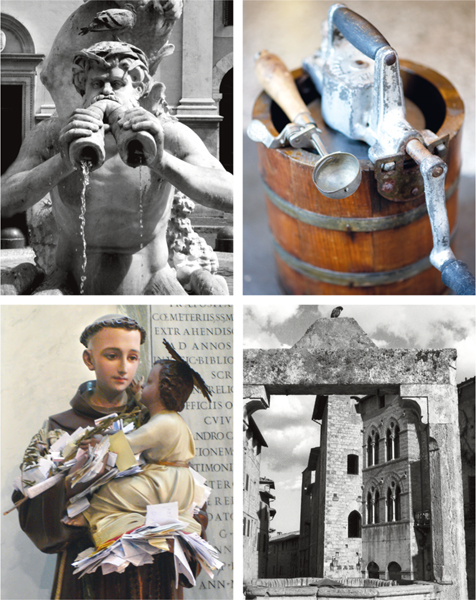
Classic Italy: a fountain in the Piazza Navona, Rome; an old-fashioned gelato maker; the historic Piazza della Cisterna, San Gimignano; a shrine in Rome, stuffed with prayers.
Many began to make use of this growing knowledge, including Bernardo Buontalenti a multi-talented Florentine artist, designer of buildings, firework festivals, feasts for the Medici family and possibly the instigator of the post-Italian Renaissance gelato boom. He and his recipes were the talk of the Italian glitterati and he was requested to take charge of organizing luxurious banquets to impress the guests of the Medici who frequently visited from other countries. To this day, Italians pay homage to him by making a gelato named after him. A is an egg enriched custard gelato, sweetened with honey and flavoured with wine. It is said he was the first to add eggs to milk to produce a custard base.
Just outside Florence, Buontalenti built Pratolini a summer residence for the Grand Duke and installed snow pits in the grounds of the villa. These were covered with an insulating pyramid of thatch designed to store icy snow carried down from the mountains for a full year without melting away. (Snow when compacted into blocks lasts a very long time.) He also had pits built in the Boboli gardens and around the walls of Florence to store snow and ice for sale to the general public who by now, just like the nobility, wanted an on-hand supply during the scorching summer months.
Concessions giving permission to collect and store snow and ice were being sold to the highest bidder. It seemed in everyones interests therefore to promote the new idea that was exciting the fashionable rich of the day. Iced follies became the big thing at grand banquets. Vast visual displays were increasingly over-the-top, with crushed ice and snow the basis for these magnificent arrangements. Showy pyramids and obelisks of seasonal fruits encased in ice, strewn with tangles of heavily scented orange blossoms, sweet jasmine and scented roses, bedecked the tables on these glamorous occasions.
Due to the huge popularity of ice and snow it made more economic sense to take ice from the local lakes and rivers, or to dig reservoirs close to the villas of the nobility and, when they filled with water and froze over in the coldest months, carve out the blocks of ice and put those into storage.
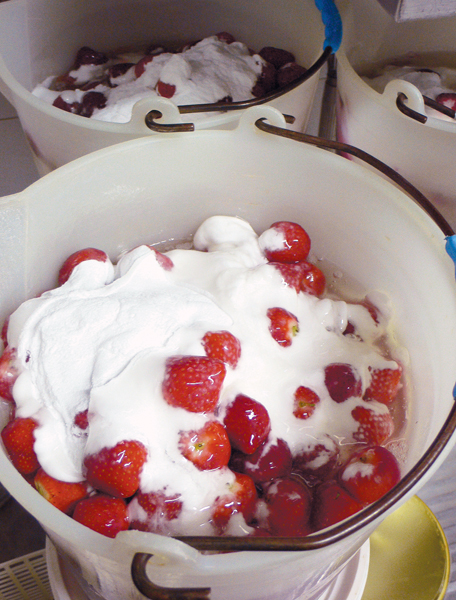
Gelato preparation at Gelateria di Piazza.
By the late 17th century Antonio Latini, an official who organized and supervised food and entertainment for the Spanish Prime Minister of Naples, started to write about entertaining and cooking, and included details on how to make ices. He masterminded the making of beautifully ornate iced serving bowls, vasi di ghiaccio , made from moulded ice containing fruits suspended inside a thinner layer of ice. He also wrote quite specific recipes for frozen flavoured ices embedded with fruit, and for sweetened milk-based ones, which were lightly frozen, then moulded into brick shapes and frozen hard. Eggs, cream and even butter were used in milk-based ices to enrich the mixture already scented with orange flower water, cinnamon and vanilla. Meanwhile, the not so wealthy population of Naples had once again adopted the ancient Roman idea of putting syrups onto snow. These were called neve (snow) and were sold on the streets, but in comparison to the grand iced arrangements at the banquets of the rich it was all relatively frugal.
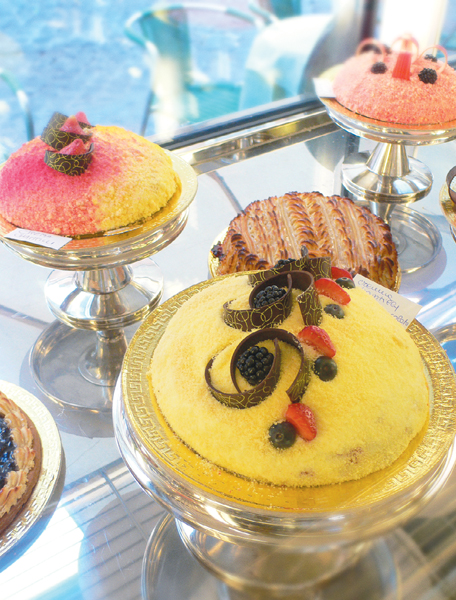
Gelato desserts.
From the late 17th century the craze for ices was spreading to the rest of Europe with the help of the now iconic Parisian caf in the Rue de lAncienne Comdie Caf Procope which is named after its one-time Sicilian owner Francesco Procopio Dei Coltelli. He went to Paris with some knowledge of how to make sorbetto, and it is believed that his grandfather, also Francesco, had designed a machine that improved the texture of ice flavoured with fruit and sweetened with honey. He was granted a royal patent to sell his ices exclusively. A century later, Guiseppe Tortoni, another Italian, was running a caf in Paris, and by then the use of cream in ices was commonplace. His sons recipe for , which is still made, became very famous.
Next page
